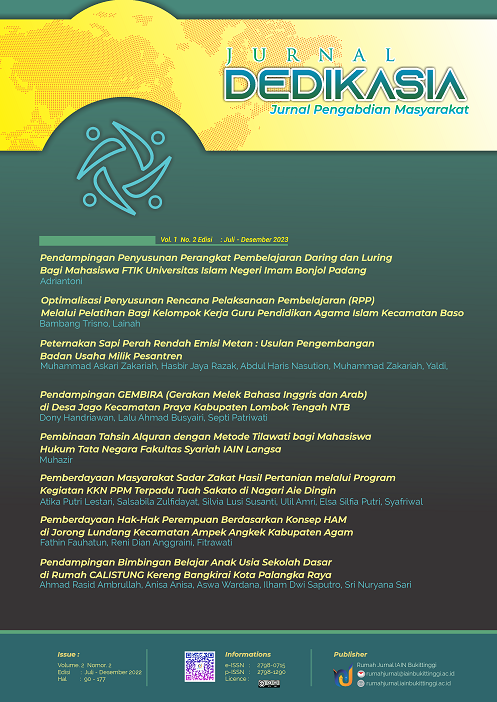Pembinaan Tahsin Alquran dengan Metode Tilawati bagi Mahasiswa Hukum Tata Negara Fakultas Syariah IAIN Langsa
DOI:
https://doi.org/10.30983/dedikasia.v2i2.5869Keywords:
Coaching, Reading Quran, Tilawati Method, Constitutional Law StudentAbstract
References
Abdurrahman, M. (1999). Pendidikan bagi anak berkesulitan belajar / Mulyono Abdurrahman. Jakarta: Rineka Cipta. https://opac.perpusnas.go.id/DetailOpac.aspx?id=91821
Aziz, A. N. S., Lusiana, E., & Tri Utami, W. (2021). Implementasi Metode Talqin dan Nada Muri Q Terhadap Program Tahfidz di SDIT AL ISLAM Sine Ngawi Jawa Timur. Jurnal Pendidikan Dasar Dan Keguruan, 6(2), 32–40. https://doi.org/10.47435/jpdk.v6i2.696
Fakultas Syariah. (n.d.). Hukum Tata Negara. Retrieved July 30, 2022, from Http://Syariah.Iainlangsa.Ac.Id/Hukum-Tata-Negara/.
Fathurrahmah, N., Amin, M., & Shinwanudin, M. (2020). Pendampingan Standarisasi Guru Taman Pendidikan Al-Qur`an Melalui Pelatihan Metode Tilawati Berbasis Aset. Janaka, Jurnal Pengabdian Masyarakat, 2(2), 65–72. https://doi.org/10.29062/janaka.v2i2.210
Fidai, R. A. (1988). Concise History of Muslim World. Kitab Bhavan. https://opac.perpusnas.go.id/DetailOpac.aspx?id=173720#
FN, A. A., & Ainurrohmah, C. (2017). Implementasi Metode Tilawati dalam Menghafal Bacaan Sholat di TPQ Miftahul Hidayah Gondang Nganjuk Jawa Timur. Jurnal Lentera: Kajian Keagamaan, Keilmuan Dan Teknologi, 1(2), 295–308. https://conference.uin-suka.ac.id/index.php/aciece/article/view/67
Hamdani, M. (2018). PENERAPAN METODE MEMBACA ALQURAN PADA TPA DI KECAMATAN AMUNTAI UTARA (Studi pada metode Iqra dan metode Tilawati). Al Qalam: Jurnal Ilmiah Keagamaan Dan Kemasyarakatan, 0(0). https://doi.org/10.35931/AQ.V0I0.12
Hermawan, D., & Jurjani, A. (2021). EFEKTIVITAS METODE TILAWATI DALAM PENINGKATAN KEMAMPUAN MEMBACA Al-QUR’AN SISWA SDIT BINTANG TANGERANG SELATAN. Jurnal Konseling Pendidikan Islam, 2(1), 168–187. https://doi.org/10.32806/JKPI.V2I1.35
Ikhsan, M., & Lisnawati, S. (2018). PENERAPKAN METODE TILAWATI DAN PENILAIAN MUNAQOSAH DALAM MENINGKATKAN MEMBACA AL-QURAN. Annual Conference on Madrasah Studies, 1(1), 119–127. http://prosiding.uika-bogor.ac.id/index.php/acmas/article/view/22
Khoiruddin, H., & Kustiani, A. W. (2020). MANAJEMEN PEMBELAJARAN TAHSIN AL-QURAN BERBASIS METODE TILAWATI. Jurnal Isema : Islamic Educational Management, 5(1), 55–68. https://doi.org/10.15575/ISEMA.V5I1.5546
Kuliyatun, K. (2020). Implementasi Metode Kritik Intrinsik dalam Meningkatkan Kemampuan Membaca Al-Quran di Madrasah Tsanawiyah Kota Metro. Edification Journal : Pendidikan Agama Islam, 2(2), 81–91. https://doi.org/10.37092/EJ.V1I2.115
Maesyaroh, Y., & Khusni Albar, M. (2022). Pendampingan baca tulis Al Qur’an dengan metode iqro’ di TPQ Al Amin Dusun Ciparakan. Connection: Jurnal Pengabdian Kepada Masyarakat, 2(1), 10–19. https://doi.org/10.32505/CONNECTION.V2I1.3370
Mahdi, M. (2021). Implementasi TQM Berbasis Metode Qiraati di TPQ Daarul Jannah Desa Kaligawe Wetan Kecamatan Susukanlebak Kabupaten Cirebon. Hadlonah : Jurnal Pendidikan Dan Pengasuhan Anak, 2(1).
Marliani, T., & Hayati, F. (2020). Efektivitas Penerapan Metode Tilawati terhadap Peningkatan Kemampuan Membaca Al-Qurâ€TMan Siswa Sekolah Dasar Itqan Islamic School Bandung. Prosiding Pendidikan Agama Islam, 6(2), 44–49. https://doi.org/10.29313/.V6I2.22671
Martono, N. (2010). Metode penelitian kuantitatif. Jakarta: Rajawali Pers.
Mawada, A. (2019). Metode Al-Barqy Terhadap Kemampuan Membaca Huruf Hijaiyah Anak Tunarungu. Jurnal Pendidikan Khusus, 12(3), 1–16. https://jurnalmahasiswa.unesa.ac.id/index.php/38/article/view/29915
Palufi, A. N., & Syahid, A. (2020). Metode Yanbu’a Sebagai Pedoman Membaca Al-Qur’an. Attractive : Innovative Education Journal, 2(1), 32–40. https://doi.org/10.51278/AJ.V2I1.21
Pujiana, S., Lisnawati, S., & Kamalludin. (2020). IMPLEMENTASI METODE TILAWATI DALAM PEMBELAJARAN AL-QUR’AN UNTUK MENUMBUHKAN KARAKTER DISIPLIN DI SMP AL-AZHAR SYIFA BUDI CIBINONG BOGOR. Jurnal Inspiratif Pendidikan, 9(1), 186–204. https://doi.org/10.24252/IP.V9I1.15204
Putra, I. A., Rahmawati, R. D., & Rofiq, A. A. (2020). Pendampingan Mengajar di Lembaga Taman Pendidikan Al-Qur’an Desa Brangkal. Jumat Keagamaan: Jurnal Pengabdian Masyarakat, 1(1), 8–12. https://ejournal.unwaha.ac.id/index.php/abdimas_agama/article/view/1024
Putri, R. A., & Sembiring, S. B. (2021). Pelatihan Desain Flyer Dan Kartu Nama dengan Metode Participatory Action Research (PAR). Jurnal IPTEK Bagi Masyarakat (J-IbM), 1(1), 1–7. https://doi.org/10.55537/JIBM.V1I1.1
Rofiq, M., & Basyid, M. A. (2020). Implementasi Metode Yanbu’a untuk Meningkatkan Hasil Belajar Baca Al-Qur’an di MI Baitul Huda Kota Semarang Tahun Ajaran 2019/2020. QUALITY, 8(2), 207–218. https://doi.org/10.21043/QUALITY.V8I2.7550
Saifuddin, & Amalia, I. A. (2018). Pengelola Pembelajaran Alquran di RA (Studi kasus Pengguna Metode Qiraat). AWLADY : Jurnal Pendidikan Anak, 4(1), 119–128.
Setyosari M.Ed, P. D. H. P. (2016). Metode Penelitian Pendidikan & Pengembangan - - Google Buku. https://books.google.co.id/books?id=SnA-DwAAQBAJ&printsec=frontcover&hl=id&source=gbs_vpt_read#v=onepage&q&f=false
Soedjiwo, N. A. F. (2019). Implementasi Mata Kuliah PAR (PARTICIPATORY ACTION RESEARCH) di TPQ AL-MAGFIROH Denpasar Bali. Widya Balina, 4(2), 9–19. https://doi.org/10.53958/WB.V4I2.36
Yusuf, N., & Arfiani, P. (2018). EFEKTIVITAS METODE TILAWATI SEBAGAI PEMBELAJARAN MEMBACA AL-QURAN PADA ANAK DISLEKSIA. Prosiding Seminar Nasional Pendidikan, 1(1). https://jurnal.umj.ac.id/index.php/SNP/article/view/2772
Zahro, N., Amirudin, N., & Arfa Ladamay, M. (2021). Implementasi Metode Tilawati Dalam Membaca al-Quran Di Taman Pendidikan al-Qur’an al-Abror Gembyang Kebomas Gresik. Jurnal Mahasiswa Pendidikan, 1(1), 139–150. https://doi.org/10.37286/JMP.V1I1.138
Downloads
Published
How to Cite
Issue
Section
Citation Check
License
Copyright (c) 2022 Muhazir

This work is licensed under a Creative Commons Attribution-ShareAlike 4.0 International License.
Authors who publish with this journal agree to the following terms:
- Authors retain copyright and grant the journal right of first publication with the work simultaneously licensed under a Creative Commons Attribution License that allows others to share the work with an acknowledgment of the work's authorship and initial publication in this journal.
- Authors are able to enter into separate, additional contractual arrangements for the non-exclusive distribution of the journal's published version of the work (e.g., post it to an institutional repository or publish it in a book), with an acknowledgment of its initial publication in this journal.
- Authors are permitted and encouraged to post their work online (e.g., in institutional repositories or on their website) prior to and during the submission process, as it can lead to productive exchanges, as well as earlier and greater citation of published work (See The Effect of Open Access).



